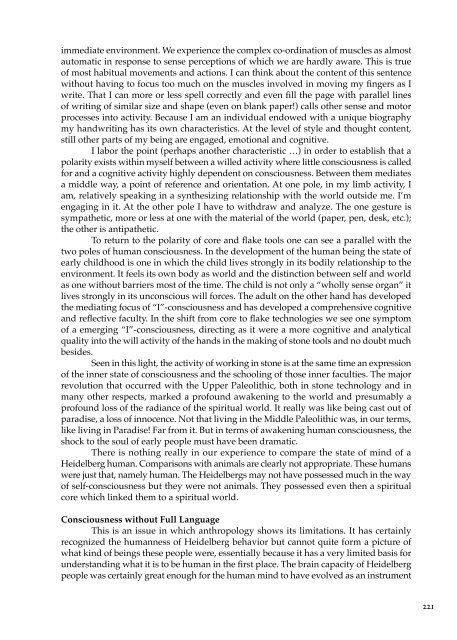The Spirit in Human Evolution - Waldorf Research Institute
The Spirit in Human Evolution - Waldorf Research Institute
The Spirit in Human Evolution - Waldorf Research Institute
You also want an ePaper? Increase the reach of your titles
YUMPU automatically turns print PDFs into web optimized ePapers that Google loves.
immediate environment. We experience the complex co-ord<strong>in</strong>ation of muscles as almost<br />
automatic <strong>in</strong> response to sense perceptions of which we are hardly aware. This is true<br />
of most habitual movements and actions. I can th<strong>in</strong>k about the content of this sentence<br />
without hav<strong>in</strong>g to focus too much on the muscles <strong>in</strong>volved <strong>in</strong> mov<strong>in</strong>g my f<strong>in</strong>gers as I<br />
write. That I can more or less spell correctly and even fill the page with parallel l<strong>in</strong>es<br />
of writ<strong>in</strong>g of similar size and shape (even on blank paper!) calls other sense and motor<br />
processes <strong>in</strong>to activity. Because I am an <strong>in</strong>dividual endowed with a unique biography<br />
my handwrit<strong>in</strong>g has its own characteristics. At the level of style and thought content,<br />
still other parts of my be<strong>in</strong>g are engaged, emotional and cognitive.<br />
I labor the po<strong>in</strong>t (perhaps another characteristic …) <strong>in</strong> order to establish that a<br />
polarity exists with<strong>in</strong> myself between a willed activity where little consciousness is called<br />
for and a cognitive activity highly dependent on consciousness. Between them mediates<br />
a middle way, a po<strong>in</strong>t of reference and orientation. At one pole, <strong>in</strong> my limb activity, I<br />
am, relatively speak<strong>in</strong>g <strong>in</strong> a synthesiz<strong>in</strong>g relationship with the world outside me. I’m<br />
engag<strong>in</strong>g <strong>in</strong> it. At the other pole I have to withdraw and analyze. <strong>The</strong> one gesture is<br />
sympathetic, more or less at one with the material of the world (paper, pen, desk, etc.);<br />
the other is antipathetic.<br />
To return to the polarity of core and flake tools one can see a parallel with the<br />
two poles of human consciousness. In the development of the human be<strong>in</strong>g the state of<br />
early childhood is one <strong>in</strong> which the child lives strongly <strong>in</strong> its bodily relationship to the<br />
environment. It feels its own body as world and the dist<strong>in</strong>ction between self and world<br />
as one without barriers most of the time. <strong>The</strong> child is not only a “wholly sense organ” it<br />
lives strongly <strong>in</strong> its unconscious will forces. <strong>The</strong> adult on the other hand has developed<br />
the mediat<strong>in</strong>g focus of “I”-consciousness and has developed a comprehensive cognitive<br />
and reflective faculty. In the shift from core to flake technologies we see one symptom<br />
of a emerg<strong>in</strong>g “I”-consciousness, direct<strong>in</strong>g as it were a more cognitive and analytical<br />
quality <strong>in</strong>to the will activity of the hands <strong>in</strong> the mak<strong>in</strong>g of stone tools and no doubt much<br />
besides.<br />
Seen <strong>in</strong> this light, the activity of work<strong>in</strong>g <strong>in</strong> stone is at the same time an expression<br />
of the <strong>in</strong>ner state of consciousness and the school<strong>in</strong>g of those <strong>in</strong>ner faculties. <strong>The</strong> major<br />
revolution that occurred with the Upper Paleolithic, both <strong>in</strong> stone technology and <strong>in</strong><br />
many other respects, marked a profound awaken<strong>in</strong>g to the world and presumably a<br />
profound loss of the radiance of the spiritual world. It really was like be<strong>in</strong>g cast out of<br />
paradise, a loss of <strong>in</strong>nocence. Not that liv<strong>in</strong>g <strong>in</strong> the Middle Paleolithic was, <strong>in</strong> our terms,<br />
like liv<strong>in</strong>g <strong>in</strong> Paradise! Far from it. But <strong>in</strong> terms of awaken<strong>in</strong>g human consciousness, the<br />
shock to the soul of early people must have been dramatic.<br />
<strong>The</strong>re is noth<strong>in</strong>g really <strong>in</strong> our experience to compare the state of m<strong>in</strong>d of a<br />
Heidelberg human. Comparisons with animals are clearly not appropriate. <strong>The</strong>se humans<br />
were just that, namely human. <strong>The</strong> Heidelbergs may not have possessed much <strong>in</strong> the way<br />
of self-consciousness but they were not animals. <strong>The</strong>y possessed even then a spiritual<br />
core which l<strong>in</strong>ked them to a spiritual world.<br />
Consciousness without Full Language<br />
This is an issue <strong>in</strong> which anthropology shows its limitations. It has certa<strong>in</strong>ly<br />
recognized the humanness of Heidelberg behavior but cannot quite form a picture of<br />
what k<strong>in</strong>d of be<strong>in</strong>gs these people were, essentially because it has a very limited basis for<br />
understand<strong>in</strong>g what it is to be human <strong>in</strong> the first place. <strong>The</strong> bra<strong>in</strong> capacity of Heidelberg<br />
people was certa<strong>in</strong>ly great enough for the human m<strong>in</strong>d to have evolved as an <strong>in</strong>strument<br />
221
















